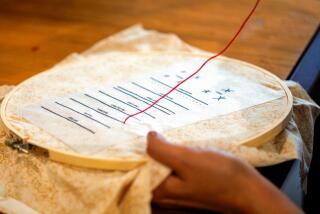Tearing the Fabric of Poverty : Garment Factory a Haven for Bangladeshi Women
- Share via
DHAKA, Bangladesh — A quiet revolution is starting behind the soft whir of sewing machines: Bangladeshi women are finding alternatives to poverty, early marriage and frequent childbirth.
In this underfed, overpopulated, disaster-prone nation, the garment industry has established itself as a success story both economically and socially.
Nahar was 12 years old when her family arranged her marriage to a pedicab puller who, she said, beat her. By 16, she was a deserted wife with an infant son.
Traditionally, the only respectable options for a poor village girl like Nahar would have been remarriage or becoming a maid. The other possibilities in Bangladesh’s limited female labor market were husking rice, pounding bricks and stones into gravel at construction sites or prostitution.
Instead, a few months after Nahar’s husband cast her out in 1985, a relative offered her a job in the fledgling garment industry.
Today, at 20, Nahar (like many Bangladeshis she uses only her first name) is a sewing machine operator at Y. K. Garments on Elephant Road in the center of Dhaka. She sends half her monthly salary of 900 takas (about $28) home to her mother in the village to take care of her 5-year-old son. Her annual salary of $336 is more than double her nation’s per capita annual income of $160.
“I feel I’m the happiest woman on Earth,” she said. “No one beats me anymore almost every night. I’m independent and I earn my own money.”
Such independence is still rare for most Bangladeshi women, but it is a beginning and it is growing.
About 300,000 women work in Bangladesh’s clothing factories, making up 90% of the industry’s work force. The number of export-oriented clothing factories swelled from four in 1979 to 722 in 1988, according to government statistics.
Export earnings shot up from $500,000 in 1979 to $450 million in 1988 and now bring in 35% of the nation’s foreign exchange.
Today, Bangladesh is the fifth-largest exporter of ready-made clothing to the United States, after Hong Kong, South Korea, Taiwan and China, according to the U.S. Embassy.
But the garment industry could help in another problem area--population growth--if more women choose to work and marry later, thereby reducing their child-bearing years.
Bangladesh is the world’s most densely populated land after the city-states of Hong Kong and Singapore. If its birth rate is not checked, its population of 110 million will double within 35 years. According to the United Nations Children’s Fund, 86% of the population already lives below the poverty level.
Ayesha Khatoon, daughter of a landless peasant in Bangladesh’s northern Rangpur district, was 11 when she fled to Dhaka in 1984 because her parents planned to marry her off to a 16-year-old boy.
“I did not want the marriage,” she said. “The job at the garment factory has saved my life. Otherwise, I would have ended up either being a maid at a rich man’s house or, who knows, in a brothel.”
Ayesha and three of her co-workers at Meghna Garments Industry Ltd. share a one-room, tin-roofed apartment. That in itself is a social breakthrough in a country where single women are expected to live with their families.
One of her roommates, 25-year-old Khodeza, said she left her husband two years ago because he insisted that they have a fifth child. The first four were girls, and he wanted a son.
“One night, I thought and thought. Suddenly, I decided that I can’t take it anymore. I must leave for a life of my own,” Khodeza said.
“The garment women have achieved a great social revolution in our conservative Muslim society,” said Sufia Kamal, a women’s rights activist and a leading poet. “They have done what many of us educated women have failed to achieve so far. Although the women are taking the jobs out of necessity, they are also silently fighting against the social taboos.”
More to Read
Sign up for Essential California
The most important California stories and recommendations in your inbox every morning.
You may occasionally receive promotional content from the Los Angeles Times.










